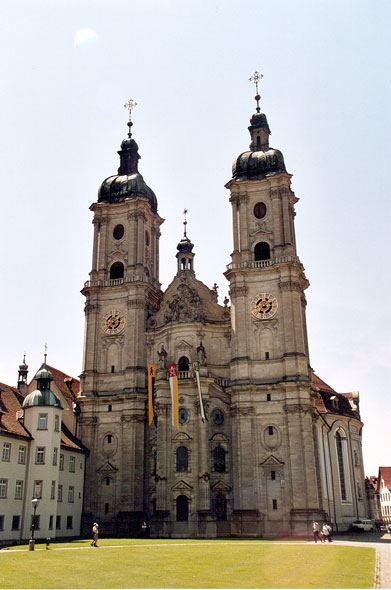Re: Re: reorganisation and destruction of irish catholic churches
Home › Forums › Ireland › reorganisation and destruction of irish catholic churches › Re: Re: reorganisation and destruction of irish catholic churches
The Abbey of Sankt Gallen in Switzerland
The abbey church:




Around 613 an Irish monk named Gallus, a disciple and companion of Saint Columbanus, established a hermitage on the site that would become the Abbey. There he lived until his death in 646.
Following Gallus’ death, Charles Martel appointed Othmar as custodian of St Gall’s relics. During the reign of Pepin the Short, in 719, Othmar founded the Carolingian style Abbey of St. Gall, where arts, letters and sciences flourished. Under Abbot Waldo of Reichenau (740–814) the copying of manuscripts was undertaken and a famous library was gathered. Numerous Anglo-Saxon and Irish monks came to copy manuscripts.
From this time until the 10th century, the Abbey flourished. It was home to several famous scholars, including Notker of Liège, Notker the Stammerer, Notker Labeo and Hartker (who developed the Antiphonal liturgical books for the Abbey). During the 9th century a new, larger church was built and the library was expanded. Manuscripts on a wide variety of topics were purchased by the Abbey and copies were made. Over 400 manuscripts from this time have survived and are still in the library today.
The new structures, including the abbey church, were designed in the late Baroque style and constructed between 1755 and 1768.
One of the gret treasures of the library is manuscript 904, Priscian’s Institutiones grammaticae, glossed in Old Irish, which contains the marginal text of the poem written in Irish in 9th century Is acher in gaÃth in-nocht/fu-fúasna fairggae findfolt;/nà ágor réimm mora minn/dond láechraid lainn úa Lothlind [The wind is fierce tonight/it tosses the sea’s white mane/I do not fear the coursing of a quiet sea/by the fierce warriors of Lothlend].
Also contained in the library is [MS 1092] the medieval Plan of Sankt Gall from about 830, the only surviving architectural drawing to survive from the period bewteen late antiquity and the 13th century. The plan was an ideal of what a well-designed and well-supplied monastery should have, as envisioned by one of the synods held at Aachen for the reform of monasticism in the Frankish empire during the early years of emperor Louis the Pious (between 814 and 817).

The Chancel

